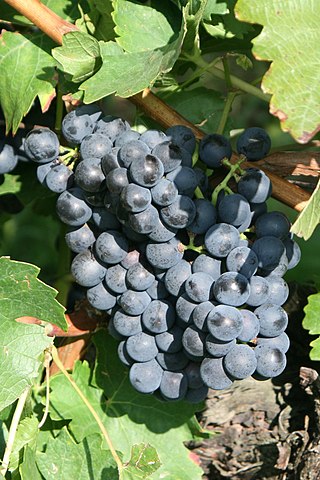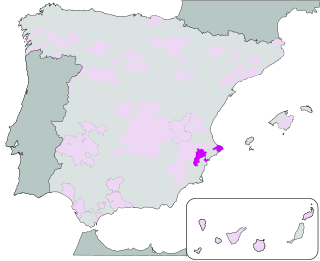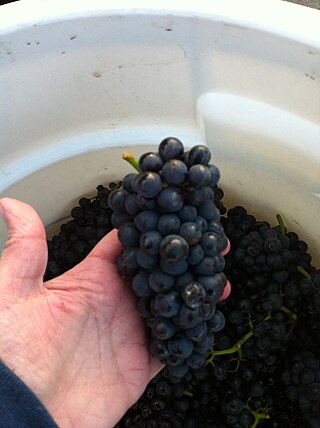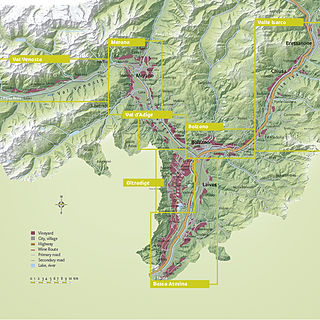
Merlot is a dark blue–colored wine grape variety, that is used as both a blending grape and for varietal wines. The name Merlot is thought to be a diminutive of merle, the French name for the blackbird, probably a reference to the color of the grape. Its softness and "fleshiness," combined with its earlier ripening, make Merlot a popular grape for blending with the sterner, later-ripening Cabernet Sauvignon, which tends to be higher in tannin.

Pinot noir is a red-wine grape variety of the species Vitis vinifera. The name may also refer to wines created predominantly from pinot noir grapes. The name is derived from the French words for pine and black. The word pine alludes to the grape variety having tightly clustered, pinecone–shaped bunches of fruit.

The Zweigelt, also known as Rotburger, is a new Austrian grape created in 1922 by Friedrich Zweigelt (1888–1964), who later became Director of the Federal Institute and Experimental Station of Viticulture, Fruit Production and Horticulture (1938–1945). It comprises a crossing between St. Laurent and Blaufränkisch.

Blaufränkisch is a dark-skinned variety of grape used for red wine. Blaufränkisch, which is a late-ripening variety, produces red wines which are typically rich in tannin and may exhibit a pronounced spicy character.

Dornfelder is a dark-skinned variety of grape of German origin used for red wine. It was created by August Herold (1902–1973) at the grape breeding institute in Weinsberg in the Württemberg region in 1955. Herold crossed the grape varieties Helfensteiner and Heroldrebe, the latter which bears his name, to create Dornfelder. Helfensteiner and Heroldrebe were both crosses created some decades earlier by Herold. Dornfelder received varietal protection and was released for cultivation in 1979. It was named in honor of Immanuel August Ludwig Dornfeld (1796–1869), a senior civil servant who was instrumental in creating the viticultural school in Weinsberg.
Hungarian wine has a history dating back to the Kingdom of Hungary. Outside Hungary, the best-known wines are the white dessert wine Tokaji aszú and the red wine Bull's Blood of Eger.

Blauer Portugieser is a red Austrian, Slovenian wine, Croatian wine, Moravian and German wine grape found primarily in the Rheinhessen, Pfalz and wine regions of Lower Austria, Slovenia and Croatia. It is also one of the permitted grapes in the Hungarian wine Egri Bikavér. In Germany, the cultivated area covered 4,551 hectares or 4.5% of the total vineyard area in 2007. Wine cellars usually vinify a simple light red wine, which is characterized by a fresh, tart and light body. It is also frequently vinified as a rosé. Blauer Portugieser is also very well suited as table grapes; however, it is not sold as such because the selling of wine grapes as table grapes is not permitted in the European Union. Since 2000, higher quality wines have been vinified from Portugieser grapes. The use of oak provides additional aromas in order to compete with Bordeaux varieties. DNA profiling has shown that Blauer Portugieser is a cross between Grüner Silvaner and Blaue Zimmettraube. Historical ampelographic sources have provided very solid evidence that the geographic area of origin of the variety is Lower Styria.

Austrian wines are mostly dry white wines, though some sweeter white wines are also produced. About 30% of the wines are red, made from Blaufränkisch, Pinot noir and locally bred varieties such as Zweigelt. Four thousand years of winemaking history counted for little after the "antifreeze scandal" of 1985, when it was revealed that some wine brokers had been adulterating their wines with diethylene glycol. The scandal destroyed the market for Austrian wine and compelled Austria to tackle low standards of bulk wine production, and reposition itself as a producer of quality wines. The country is also home to Riedel, makers of some of the most expensive wine glasses in the world. Some of the best producers of Austria include Weingut Bründlmayer, Weingut F.X. Pichler and Weingut Franz Hirtzberger, Weingut Hutter, Weingut Eigl and Wellanschitz.
Blauburger is a red wine grape variety that is grown a little in Austria, Czech Republic and Hungary. It should not be confused with Blauburgunder, which is an Austrian synonym for Pinot noir.

Alicante is a Spanish Denominación de Origen Protegida (DOP) for wines located in the province of Alicante.

Slovenia has more than 28,000 wineries making between 80 and 90 million litres annually from the country's 22,300 ha of vineyards. About 75% of the country's production is white wine. Almost all of the wine is consumed domestically with only 6.1 million L a year being exported—mostly to the United States, Bosnia and Herzegovina, Croatia, and lately the Czech Republic. Most of the country's wine production falls under the classification of premium (vrhunsko) wine with less than 30% classified as basic table wine (namizno vino). Slovenia has three principal wine regions: the Drava Wine-Growing Region, the Lower Sava Wine-Growing Region, and the Littoral Wine-Growing Region.

Bronner is a white grape variety used for wine. It was bred in 1975 by Norbert Becker at the viticultural institute in Freiburg, Germany. The variety was initially known under its breeding code FR 250-75, and was later named in honour of Johann Philipp Bronner (1792-1864), who was a German pharmacist and viticultural pioneer. It received varietal protection in 1977.

Dutch wine is wine made in the Netherlands. Although a small producer of wine, it is nowadays a strong growing branch of Dutch agriculture. Currently, the country has 180 commercial vineyards.

Pinot Noir Précoce or, as it is called in parts of Germany, Frühburgunder is a dark, blue-black–skinned, variety of grape used for wine and is a form or mutation of Pinot noir, which differs essentially by ripening earlier than normal. Whilst sometimes treated as a separate grape variety by ampelographers, there are nevertheless those who consider it is simply an early ripening form of Pinot Noir, and in some cases, Pinot Noir Précoce wines may therefore be found straightforwardly labelled "Pinot noir".

Mikulovská is one of four Czech wine regions within southern Moravia, Czech Republic. The Mikulovská wine region, containing 30 wine villages, is famed for producing white wines grown in the limestone soils, particularly in and around the area of the Pálava Landscape Protected Area. Historically a centre of viticulture and winemaking in Moravia, Mikulovská is home to the historical town of Mikulov, and the Czech National Wine Centre and Wine Salon of the Czech Republic, located at Valtice Castle.

South Tyrol is an autonomous province located in north-east Italy producing wine. This Austro-Italian wine region is noted for the distinct Austrian influences on the wine industry due to the region's long history under the rule of Austria-Hungary and Holy Roman Empires.
Petit Bouschet is a red teinturier grape variety that is a crossing of Aramon noir and Teinturier du Cher created in 1824 by French grape breeder Louis Bouschet at his vineyard in Mauguio in the Hérault department. The grape was used by Louis' son, Henri Bouschet, to create several more varieties including Alicante Bouschet, Grand Noir de la Calmette and Morrastel Bouschet. Petit Bouschet saw a surge of plantings in the late 19th century as France recovered from the phylloxera epidemic where it was often used to add color to blends made from hybrid grapes and other high yielding varieties. As its offspring Alicante Bouschet became more popular, plantings of Petit Bouschet fell off and the grape is now hardly found in France.

Wine Grapes - A complete guide to 1,368 vine varieties, including their origins and flavours is a reference book about varieties of wine grapes. The book covers all grape varieties that were known to produce commercial quantities of wine at the time of writing, which meant 1,368 of the known 10,000 varieties. It is written by British Masters of Wine Jancis Robinson and Julia Harding in collaboration with Swiss grape geneticist Dr. José Vouillamoz.
Cabernet blanc is a white German and Swiss wine grape variety that is a crossing of the French wine grape Cabernet Sauvignon and Regent. The grape was bred by Swiss grape breeder Valentin Blattner in 1991. Cabernet blanc has strong resistance to most grape disease including botrytis bunch rot, downy and powdery mildew and tends to produce loose clusters of small, thick-skinned grape berries which can hang on the vine late into the harvest season to produce dessert wines. Today the grape is found primarily in the Palatinate wine region of Germany with some experimental plantings in Spain and the Netherlands. In France, in the Languedoc, Domaine La Colombette is heavily investing in PIWI grapes. Amongst others the Cabernet Blanc in their cuvée "Au Creux du Nid", is gaining wide acclaim.

Hahndorf Hill Winery, also known as HHW, is a boutique vineyard situated adjacent to the historic, German-heritage village of Hahndorf, South Australia, in the Adelaide Hills wine region.
















